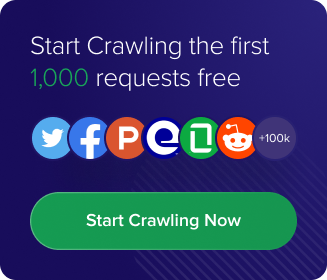Websites are becoming increasingly difficult to crawl and scrape each year. More JavaScript, more anti-bot systems, and constant design changes. Octoparse has been a solid choice for individuals who prefer a simple, click-and-go setup, but it’s not always the best option if you need something faster, more flexible, or capable of scraping at scale.
That’s where Octoparse’s alternative, Crawlbase steps in. API first, fast, and designed to handle big, messy scraping jobs without breaking a sweat. It’s built with developers in mind. If you need a few pages for a side project or you’re running huge crawls day after day, choosing the right tool now can save you a ton of problems down the road.
In this guide, we’ll walk you through what’s new with both Octoparse and Crawlbase in 2025, how they hold up in real-world use, and which one might make the most sense for what you’re working on.
- Octoparse vs Crawlbase: Key Feature Comparison
- Pricing Overview
- Extra Costs: Add-Ons vs All-Inclusive
- Performance & Reliability
- Final Verdict: Which One Should You Choose?
Quick Comparison: Crawlbase vs Octoparse
| Tool | Speed & Scalability | Reliability Highlights |
|---|---|---|
| Octoparse | Decent on simple sites; inconsistent on complex tasks; scaling needs more work | Uptime ~99.2%; success varies 43-100%; error handling can be weak depending on site |
| Crawlbase | Ready for large-scale scraping; asynchronous processing available | Uptime ~99.9%; success ~99%; handles bot blocking automatically |
Key Features Comparison Between Crawlbase and Octoparse
Octoparse and Crawlbase can both accomplish the task, but they approach it in distinctly different ways. Octoparse leans into the whole drag-and-drop, no-code vibe, while Crawlbase is more of a “give me the API and let me handle it” kind of tool. If you’re wondering how they really compare in 2025, here’s the side-by-side breakdown.
Crawlbase vs Octoparse Key Features
| Feature | Crawlbase (2025) | Octoparse (2025) |
|---|---|---|
| Ease of Use | API-first design, better suited for developers | Drag-and-drop interface, ideal for beginners |
| Templates & Integrations | No templates, but full flexibility for any site via API and supports complex JS rendering | Dozens of ready-made templates for e-commerce, social media, and maps; new AI & RSS integrations |
| Performance | Handles high-volume, JS-heavy, and geo-targeted scraping with ~99% success rate | Fast on simple pages, slower on heavy JS; accuracy ~96-97% |
| Anti-Bot Handling | Built-in CAPTCHA bypass, proxy rotation, and smart IP selection | Limited; relies on cloud rendering and IP pools |
| Pricing | Pay-as-you-go and subscription plans; transparent usage-based pricing | Starts at ~$83/month; with limited tasks and concurrent processes |
| Scalability | Scales from small jobs to millions of pages seamlessly | Best for small to mid-size projects |
| API Access | Core of the platform; full developer documentation and logs | Available only on higher plans |
| Best For | Technical users, enterprise-scale data extraction | Non-technical users, quick setup |
Differences Between Crawlbase and Octoparse Pricing
Octoparse and Crawlbase employ distinctly different pricing approaches. Octoparse operates on a subscription model: you pay a set monthly fee, regardless of whether you utilize all of your credits or not. Crawlbase takes the opposite route with the Crawling API using a pay-per-success system. You’re only charged when a request actually works and brings back data.
That distinction matters. With subscriptions, any unused credits expire at the end of the billing cycle, which can feel like throwing money away if your scraping needs change from month to month. With pay-as-you-go, there’s no waste; you pay only for the results you get.
Here’s what the numbers look like if we compare Octoparse’s Standard plan against Crawlbase’s Crawling API. Using Amazon as an example, we can clearly see what kind of value you get for your money.
Value Comparison at $83
| Feature | Octoparse – Standard Plan ($83/mo) | Crawlbase – Crawling API ($83 value) |
|---|---|---|
| Pricing Model | Flat monthly fee | Pay-per-success ($1.28 / 1,000 successful Amazon requests) |
| Requests / Tasks | Max 100 tasks | ~65,000 successful Amazon requests |
| Concurrency | Up to 3 concurrent cloud processes | Default 20 requests per second (~1.7M/day) |
| Scaling Limits | Task cap + concurrency bottleneck | No artificial caps, only budget-based |
| Reliability on Amazon | Varies, failures still consume time | Built-in CAPTCHA Bypass & IP rotation, billed only for success |
| Data Export | Unlimited export (within task limits) | Unlimited export by default |
| Proxies | Residential proxies included | Optimized residential + datacenter mix |
| Best Use Case | Small scraping projects with fixed scope | High-volume, Amazon-scale, success-based crawling |
So while Octoparse locks you into a fixed fee, Crawlbase adjusts to your actual usage. It not only saves you from wasting credits, but it also scales more naturally with your projects.
If you’re a developer or working on bigger projects, Crawlbase’s API-first design and robust proxy network make it easy to ramp up scraping without hitting limits or slowdowns. For teams who want control and flexibility, Crawlbase often feels like the better fit.
So if you want to scrape Amazon reliably without chasing errors, you’ll get more value out of your $83 with Crawlbase.
Extra Costs: Add-Ons vs All-Inclusive
Octoparse’s Standard plan might look straightforward on paper, but the real cost doesn’t always stop at the subscription fee. If you need residential proxies, CAPTCHA bypass, or additional scraping templates, each of these services comes with its own price tag. For anyone running larger jobs, those add-ons can quickly accumulate and push the bill far beyond the base $83 per month.
Crawlbase, on the other hand, keeps it simple. Everything you need is included from the start. Proxies, CAPTCHA bypass, data scrapers, and even cloud storage. There’s no worrying about whether you’ll have to tack on another service to keep your crawler running.
Add-Ons Comparison
| Feature | Octoparse (Standard Plan) | Crawlbase (Crawling API) |
|---|---|---|
| Residential Proxies | $3 per GB (extra cost) | Always included (residential + datacenter mix) |
| CAPTCHA Bypass | $1-1.5 per 1,000 (extra cost) | CAPTCHA Bypass included |
| Data Scrapers/Templates | $0.001-3 per 1,000 results (extra cost) | Ready to use, no extra charge |
| Cloud Storage | Limited, setup required | Free up to 10,000 documents |
Performance & Reliability
When choosing a scraping tool, two factors usually make or break the experience: how fast it runs and whether it quickly holds up over time. Let’s see how Octoparse and Crawlbase compare when you put them to work.
Crawlbase
Crawlbase, by contrast, leans heavily toward developers who care about scale and automation. You’re looking at 99.9%+ uptime, Smart AI Proxy rotation that works in the background, automatic CAPTCHA bypass, and success rates that hover around 99% on most sites. For bulk jobs, the Crawler retries failures automatically, so you don’t have to handle the process manually.
People using it tend to mention how stable it feels and how quickly those who use support respond. One review literally just put it as: “Stable service, fast support, overall performance is very good.” Crawlbase offers round-the-clock support via email and chat, which is crucial if your crawler breaks at 2 AM and you actually need a human response.
Octoparse
According to independent testing, You’ll see speeds of about 500-1,000 rows a minute, which isn’t bad at all. Once you factor in heavier, JavaScript-driven sites, however, it slows down significantly, closer to 100-300 rows per minute. Their cloud has been tested to achieve around 99.2% uptime and approximately 96-97% accuracy, which is decent but not flawless.
Now here’s where opinions split. Some users say it’s quick and painless, while others have seen the opposite. For example, one test showed it taking 15-30 minutes to scrape 1,000 records from a simple site. On larger, multi-page jobs, it took 2-3 hours, while a handwritten script could have completed it in under half an hour. Across a test of 100 websites, it achieved clean results less than half the time, and in about 15% of cases, manual data cleaning was required.
That said, not everyone struggles. There are reports of someone scraping 50,000 Amazon listings in under two hours with perfect accuracy, and another pulling in a million product reviews in about five hours by splitting the load across multiple crawlers. So, results vary a lot.
The Takeaway
If you need something visual and simple for small scraping runs, Octoparse can efficiently handle the task. However, suppose you’re serious about scale or dealing with the tougher sites that utilize more challenging CAPTCHA, JS rendering, or geo-blocking. In that case, Crawlbase is a better option.
Final Verdict: Which Solution Is the Best Octoparse Alternative in 2025?
Crawlbase is hard to beat. With its pay-per-success model, you never waste credits, and the reliability is solid enough for production workloads. It’s built for automation, integrates easily with code, and handles the messy parts (proxies, CAPTCHA, retries) in the background so you don’t have to.
Ultimately, the right pick depends on how deeply you want to approach scraping and how much control you need over the process.
Do you like to see the difference yourself? Start web scraping with Crawlbase and get your first successful requests in minutes.









